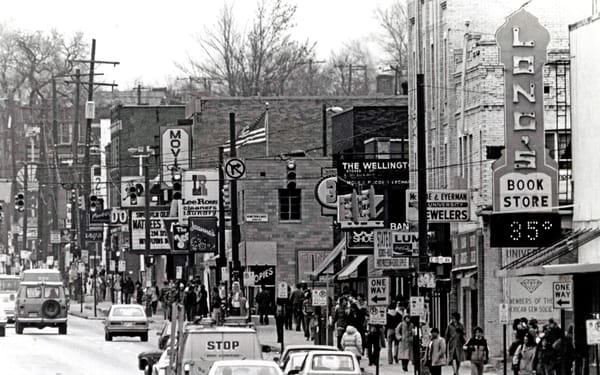There's a 'Zone In Columbus' meeting on Monday
And, thanks to you, our Spring Strategy Session was a success.

What: Zone In Columbus Update
When: Monday, April 10 from 11am to Noon
Where: Online via WebEx
Who: Neighbors who want more neighbors
Why: To stay up-to-date on the city’s zoning modernization
We hope you’ll attend Monday’s meeting, and just in case there’s opportunity for input please keep these zoning reform suggestions in your back pocket:
- Allow duplexes, triplexes, and other medium-density (i.e. “missing middle”) housing in all neighborhoods *by right*, meaning without variances
- Eliminate parking requirements, instead shifting to parking maximums
- Offer fast-track approvals for projects with affordable housing units
- Simplify approvals for accessory dwelling units (ADUs) used as long-term residences throughout the city
- Modernize the role of area commissions in approving housing
- Create special permitting pathways for non-market and de-commodified housing
- Re-examine height restrictions, especially along transit corridors
- Prioritize/expedite approval process for projects that increase housing stock (as opposed to projects removing housing units)
- Create simplified permit pathways for innovative housing options like co-living, cooperative residences, and tiny homes
- Diversify housing voices in public participation and consider the housing needs of future residents, not only current homeowners
💐 Thanks for making our Spring Strategy Session a success! 🥑

For our first strategy session—actually for any event—this was a fantastic exercise and demonstration of what a bunch of strangers can do with 90 minutes at the public library. This was an opportunity to explain the founding, activities, and mission of N4MN Columbus while getting real-time feedback from supporters. Here we’ll share some of the key takeaways from our time together.
You told us to focus on positive messaging, like how N4MN wants to give people more housing options throughout Central Ohio. Normalizing development—as well as density—was another focus. A city that’s not changing isn’t a dynamic place to be. We know change is happening, so let’s work to create a policy ecosystem that makes it the best we possibly can.
In general, you told us to pay more attention to:
- Mixed-use zoning
- Developer size, capital, and political power—consider policy reforms that would privilege and incentivize small developers
- Climate change and environmental benefits of compact, walkable communities
- Aging in place, adding housing options for all life stages in every neighborhood and municipality
- Linking jobs to housing (e.g. Intel in New Albany)
We also talked about challenges, like how in a world with so many pressing needs that require immediate attention, a topic like zoning reform can come off as superfluous. This means our strategy is unlikely to leverage a sense of urgency. However, the opportunity to modernize the zoning code—as is happening in Columbus—is likely a once-in-a-lifetime occurrence!
As far as content you’d like to see from us, we heard that explanatory pieces for local government development processes would be helpful, along with more in-depth discussions of zoning policies and advisory bodies like area commissions. Additionally, more technical discussions of density—and what different levels of density look like at the neighborhood scale—would be helpful for imagining what our communities could look like in the future. What kind of density is best? What do different kinds of density look like?
Thanks to an engaged and enthusiastic group of attendees, we have a clear vision for the next steps and focus areas of N4MN Columbus. Thank you to everyone who attended and we’re looking forward to building a community of pro-housing supporters to advocate for meaningful zoning reform throughout Central Ohio!
📚 The Book Beat

In Fixer-Upper, economist Jenny Schuetz takes a broad approach to recommending policy interventions to stabilize our expanding housing crisis.
Schuetz, J. (2022). Fixer-Upper: How to Repair America’s Crumbling Housing Policies. Brookings Institution Press.
Schuetz’ recent book is a broad-based evaluation and policy prescription for housing in the United States that follows pro-housing tenets of supply, stability, and support (also see The Affordable City, by Shane Phillips). The solutions she proposes are diverse, addressing multiple scales of governance from local and regional to state and federal.
In addition to a thorough critique of the dominant home-building paradigm in the U.S. as subsidizing the wealthy and failing to externalize costs of car-dependent sprawl, Schuetz also discussed the concept of localism. This is the idea that existing residents should have veto power over proposed housing. Under the guise of public participation, small but vocal groups of residents in areas of the highest housing demand essentially exercise veto power over where, how much, and whether or not to provide housing in their communities.
“In many parts of the United States, the development process gives too much deference to current residents—especially affluent homeowners who don’t want their communities to change. But those preferences are imposing economic, environmental, and social costs on the rest of the country—especially on low-income people, Black and Latino families” (Schuetz, 2022, p. 14).
At the heart of Schuetz’ recommendations lies zoning reform. She recommends a carrot-and-stick approach that would entice, or coerce, municipalities to open their communities to diverse housing forms. In reality, she isn’t shy to note that this means “local governments will likely have to cede some control over land use policy to state or federal governments—or pay financial penalties” (Schuetz, 2022, p. 167).
While the likelihood of federal zoning reform (or state reform in Ohio) is slim, she argues that “[a]s long as land use regulation is entirely a matter of local control, it will be impossible to achieve widespread zoning reform” (Schuetz, 2022, p. 34). Perhaps in a similar fashion with other federal measures that addressed racial and gender segregation, we’ll see a groundswell of support for legalizing multifamily housing attached to critical regional, state, or federal funding streams that will bring communities into line with the harsh reality of our nation’s housing shortage.




